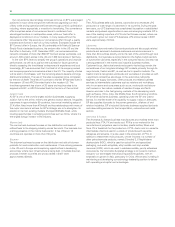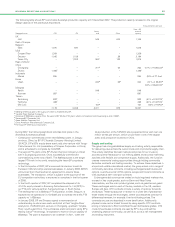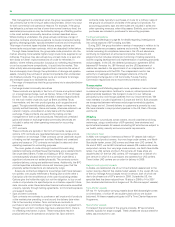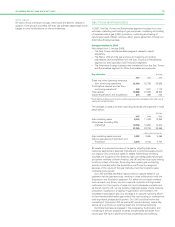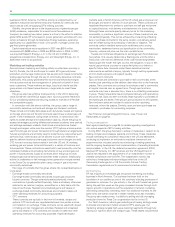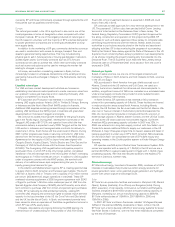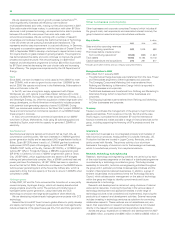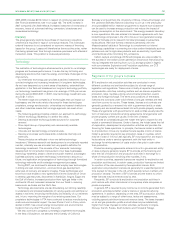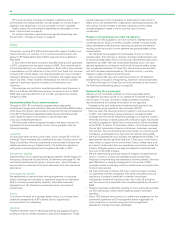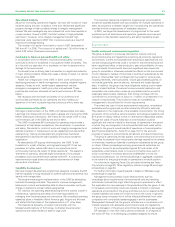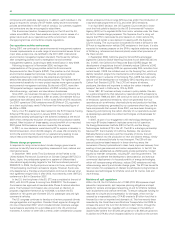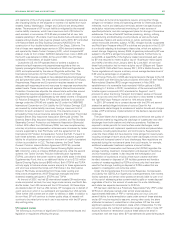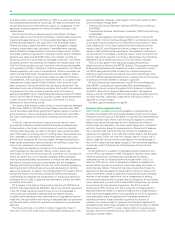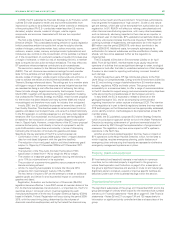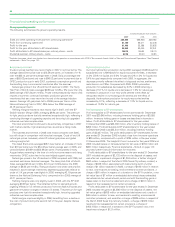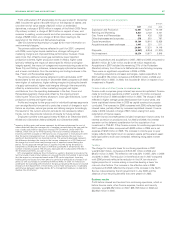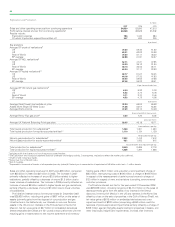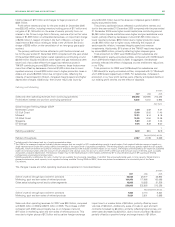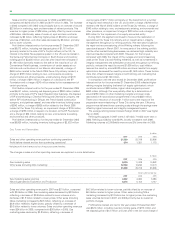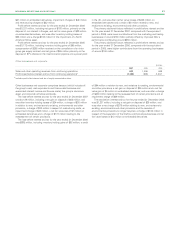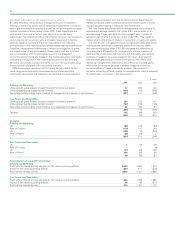BP 2007 Annual Report Download - page 44
Download and view the complete annual report
Please find page 44 of the 2007 BP annual report below. You can navigate through the pages in the report by either clicking on the pages listed below, or by using the keyword search tool below to find specific information within the annual report.
42
compliance with applicable regulations. In addition, each individual in the
group is required to comply with BP health, safety and environmental
policies as embedded in the BP code of conduct. Our partners, suppliers
and contractors are also encouraged to adopt them.
This Environment section focuses primarily on the US and the EU,
where around 65% of our fixed assets are located, and on issues of a
global nature such as our operations and the environment, climate
change programmes and maritime oil spills regulations.
Our operations and the environment
During 2007, we continued to use environmental management systems
to seek improvements on a wide range of environmental issues. All our
major sites, except one, are certified to the ISO 14001 international
environmental management system standard. The Texas City refinery,
after completing planned work to strengthen its environmental
management systems, is planning to seek recertification in early 2009.
Following its approval in November 2006, we began the
implementation of the group practice called the Environmental
Requirements for New Projects (ERNP). This practice is a full life-cycle
environmental assessment process. It requires all new projects to
undertake screening to determine the potential environmental
sensitivities associated with the proposed projects. The highest level of
environmental sensitivity in a new project requires more rigorous specific
environmental management activities. By the end of 2007, more than
100 projects had begun implementation of ERNP including those in our
alternative energy, upstream and downstream businesses.
Since 2001, we have been focusing on measuring and improving the
carbon intensity of our operations. After six years, we estimate that our
operations have delivered some 7 million tones (Mte) of GHG reductions.
Our 2007 operational GHG emissions were 63.5Mte of CO
2
equivalent
on a direct equity basis, nearly 1Mte lower than the reported figure of
64.4Mte in 2006.
Many of our EU assets have been subject to the EU Emissions Trading
Scheme (ETS) since its launch in January 2005. The number of
installations actively participating in the scheme increased at the end of
2007 when a temporary exclusion of exploration and production assets
expired. After inclusion of these assets, around one-fifth of our reported
2007 global GHG emissions are now covered by the scheme.
In 2007, no new decisions were taken by BP to explore or develop in
World Conservation Union (IUCN) category I-IV areas. We constantly try
to limit the environmental impact of our operations by seeking to use
natural resources responsibly and reducing waste and emissions.
Climate change programmes
In response to rising concerns about climate change, governments
continue to identify fiscal and regulatory measures at local, national and
international levels.
In December 1997, at the Third Conference of the Parties to the
United Nations Framework Convention on Climate Change (UNFCCC) in
Kyoto, Japan, the participants agreed on a system of differentiated
international legally-binding targets for the first commitment period of
2008-2012. In 2005, the Kyoto protocol came into force, committing the
176 participating countries to emissions targets. However, Kyoto was
only designed as a first step and policymakers continue to discuss what
new agreement might follow it after 2012, most recently at the UNFCCC
conference in Bali in December 2007.
In the EU, the first phase of the EU ETS was completed at the end of
2007, with EU ETS phase II running from 2008-2012. The European
Commission has approved all member-state Phase-II national allocation
plans. The European Commission also announced an intention to
propose a legislative framework by mid-2008, to achieve the EU
objective of 120 grams per kilometre CO
2
for passenger cars and light
commercial vehicles.
The US congress continues to develop and review proposed climate
change legislation and regulation. President Bush signed an Energy bill
into law in December 2007, which included stricter corporate average
fuel emissions standards for automobiles sold in the US and biofuel
mandates. A number of other bills currently under consideration propose
stricter emissions limits on large GHG sources and/or the introduction of
a cap-and-trade programme on CO
2
and other GHG emissions.
In an April 2007 decision, the US Supreme Court overruled a lower
court that had upheld a decision by the US Environmental Protection
Agency (EPA) not to regulate GHGs from motor vehicles under the Clean
Air Act for climate change purposes. The Supreme Court’s ruling will
require the EPA to reconsider its prior decision on motor vehicle CO
2
regulation and render a new decision in keeping with the Supreme
Court’s holding. The court opinion is expected to make it difficult for the
EPA not to regulate motor vehicle GHG emissions in the future. It is also
expected to increase pressure on the EPA to regulate stationary sources
of GHGs (e.g. refineries and chemical plants) under other provisions of
the Clean Air Act.
In September 2006, California governor Arnold Schwarzenegger
signed the California Global Warming Solutions Act of 2006 (AB 32) into
law. In 2007, the California Air Resources Board (CARB) began the
development of regulations that will ultimately reduce California’s GHG
emissions to 1990 levels by 2020 (an approximately 25% reduction from
current levels). CARB has initiated work on the Scoping Plan, which will
identify reduction programme mechanisms and timelines for achieving
the 2020 target. In advance of the Scoping Plan, CARB has taken early
actions with the development of mandatory GHG reporting and a Low
Carbon Fuel Standard (LCFS). The LCFS will require all refiners,
producers, blenders and importers to reduce the carbon intensity of
transport fuel sold in California by 10% by 2020.
Since 1997, BP has been actively involved in policy debate. We also
ran a global programme that reduced our operational GHG emissions by
10% between 1998 and 2001. We continue to look at two principal kinds
of emissions: operational emissions, which are generated from our
operations such as refineries, chemicals plants and production facilities;
and product emissions, generated by our customers when they use the
fuels and products that we sell. Since 2001, we have been focusing on
measuring and improving the carbon intensity of our operations as well
as developing sustainable low-carbon technologies and businesses for
the future.
In 2007, as part of our engagement with technology development,
two major BP-backed research institutes came into full operation:
the Energy Biosciences Institute (EBI) in the US, and the Energy
Technologies Institute (ETI) in the UK. The EBI is a strategic partnership
between BP, the University of California, Berkeley, the Lawrence
Berkeley National Laboratory and the University of Illinois, that will
perform research into the production of new and cleaner energy, initially
focusing on advanced biofuels for road transport. The EBI will also
pursue bioscience-based research in three other key areas: the
conversion of heavy hydrocarbons to clean fuels, improved recovery from
existing oil and gas reservoirs and carbon sequestration. In the UK, the
ETI has been established as a 50:50 public private partnership, funded
equally by member companies, including BP, and the government. The
ETI aims to accelerate the development, demonstration and eventual
commercial deployment of a focused portfolio of energy technologies,
which will increase energy efficiency, reduce GHG emissions and help
achieve energy security and climate change goals. The ETI has issued its
first Invitation for expressions of interest to participate in programmes to
develop new technologies for offshore wind and for marine, tidal and
wave energy.
Maritime oil spill regulations
Within the US, the Oil Pollution Act of 1990 (OPA 90) imposes oil spill
prevention requirements, spill response planning obligations and spill
liability for tankers and barges transporting oil and for offshore facilities
such as platforms and onshore terminals. To ensure adequate funding for
response to oil spills and compensation for damages, when not fully
covered by a responsible party, OPA 90 created a $1-billion fund that is
financed by a tax on imported and domestic oil. This has recently been
amended by the Coast Guard and Maritime Transportation Act 2006 to
increase the size of the fund from $1 billion to $2.7 billion, through the
previously-mentioned tax, together with an increase in the liability of
double-hulled tankers from $1,200 per gross ton to $1,900 per gross ton.
In addition to OPA 90, which imposes liability for oil spills on the owners


